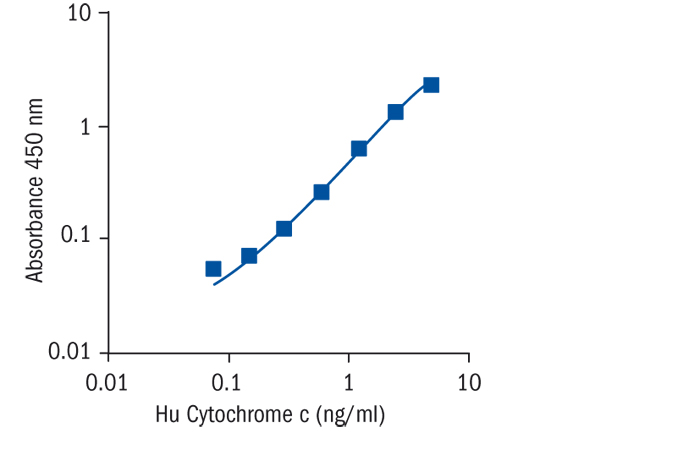Type
Sandwich ELISA, Biotin-labelled antibody
Applications
Cell culture lysate
Sample Requirements
100 µl/well
Shipping
At ambient temperature. Upon receipt, store the product at the temperature recommended below.
Storage/Expiration
Store the complete kit at 2–8°C. Under these conditions, the kit is stable until the expiration date (see label on the box).
Calibration Curve
Calibration Range
0.08–5 ng/ml
Limit of Detection
0.05 ng/ml
Intra-assay (Within-Run)
CV = 6.0%
Inter-assay (Run-to-Run)
CV = 4.0%
Spiking Recovery
82,00%
Dilution Linearity
98,00%
Research topic
Apoptosis, Immune Response, Infection and Inflammation, Oxidative stress
Summary
Apoptotic cell death is a fundamental feature of virtually all cells. It is an indispensable process during normal development, tissue homeostasis, development of the nervous system and the regulation of the immune system. Insufficient or excessive cell death can contribute to human disease, including cancer or degenerative disorders. The highly coordinated and stereotyped manner of this induced cell death suggests that the cells activate a common death program, towards which diverse signal – transducing pathways converge.
The mitochondria turned out to participate in the central control or executioner phase of the cell death cascade. Cytochrome c was identified as a component required for the crucial steps in apoptosis, caspase-3 activation and DNA fragmentation.
Cytochrome c was shown to redistribute from mitochondria to cytosol during apoptosis in intact cells.
Mitochrondrial cytochrome c is a water–soluble protein of 15 kDa with a net positive charge, residing loosely attached in the mitochrondrial intermembrane space. Cytochrome c functions in the respiratory chain by interaction with redox partners. It is highly conserved during evolution. Like most mitrochondrial proteins cytochrome c is encoded by a nuclear gene and synthesized as a cytoplasmic precursor molecule, apocytochrome c, which becomes selectively imported into the mitochondrial intermembrane space. The molecular mechanisms responsible for the translocation of cytochrome c from mitochondria to cytosol during apoptosis are unknown.
A reduction in mitochondrial transmembrane potential has been reported to accompany early apoptosis. The release of cytochrome c into the cytosol leads to an activation of an apoptotic program via activation of a caspase dependent pathway. Cytochrome c achieves this goal by interaction with other cytosolic factors forming a complex (apoptosome) composed of cytochrome c, Apaf-1, dATP and Apaf-3/caspase 9. Bcl-2 on the other hand was shown to be able to prevent apoptosis by blocking the release of cytochrome c from mitochondria.
Measurement of cytochrome c release from the mitochondria is a tool to detect the first early steps for initiating apoptosis in cells. Cytochrome c release in the cytosol occurs prior to the activation of caspases and DNA fragmentation which is considered the hallmark of apoptosis.
Detection of cytochrome c released from the mitochondria to the cytoplasm can be achieved by a selective lysis of the cell membrane.
Very recently it has been shown that this mitochondria dwelling molecule can be detected in the medium already 1h after apoptosis. Moreover, elevated cytochrome c levels were observed in serum from patients with hematological malignancies. In the course of cancer chemotherapy, the serum-cytochrome c level grew rapidly and it decreased gradually as the patient was cleared from malignant cells. Thus, serum-cytochrome c monitoring might serve as a clinical marker indicating the onset of apoptosis and cell turn-over in vivo.
Find documents for the lot
Example Instructions for Use (RUO)
Example Instructions for Use (RUO)
Safety Information (RUO)
MSDS (RUO)

